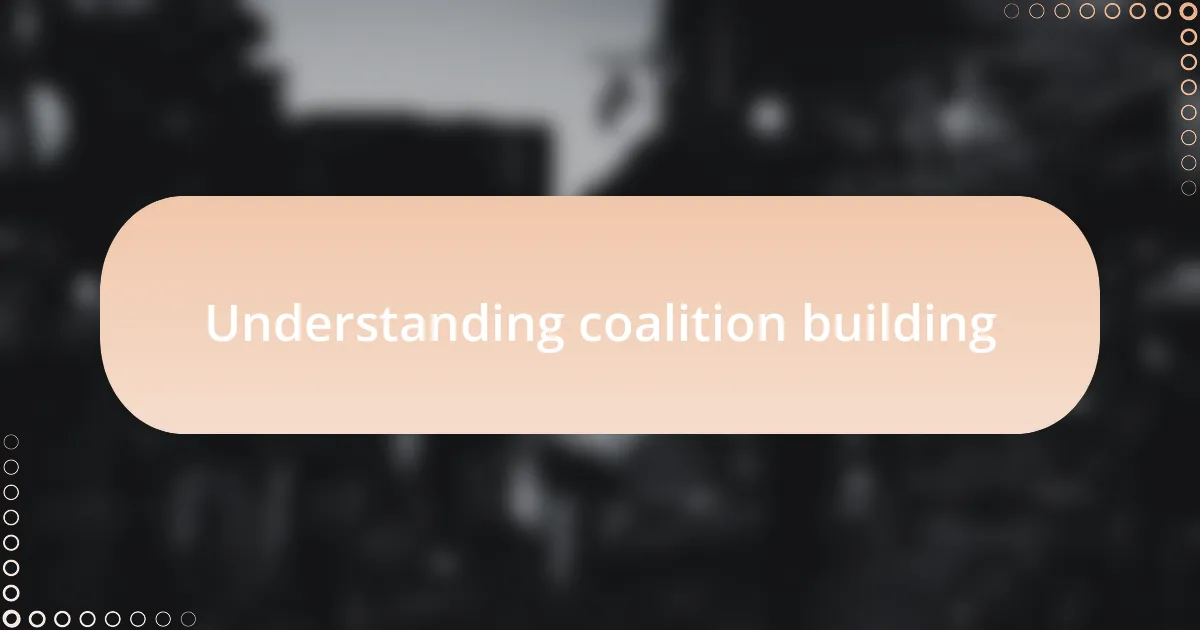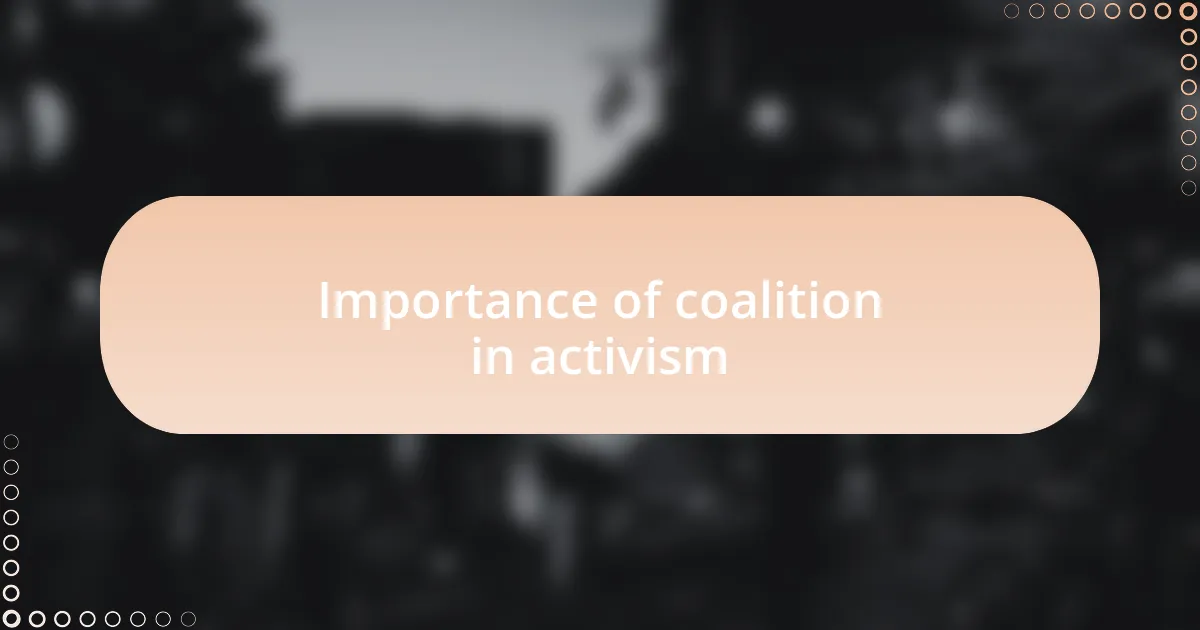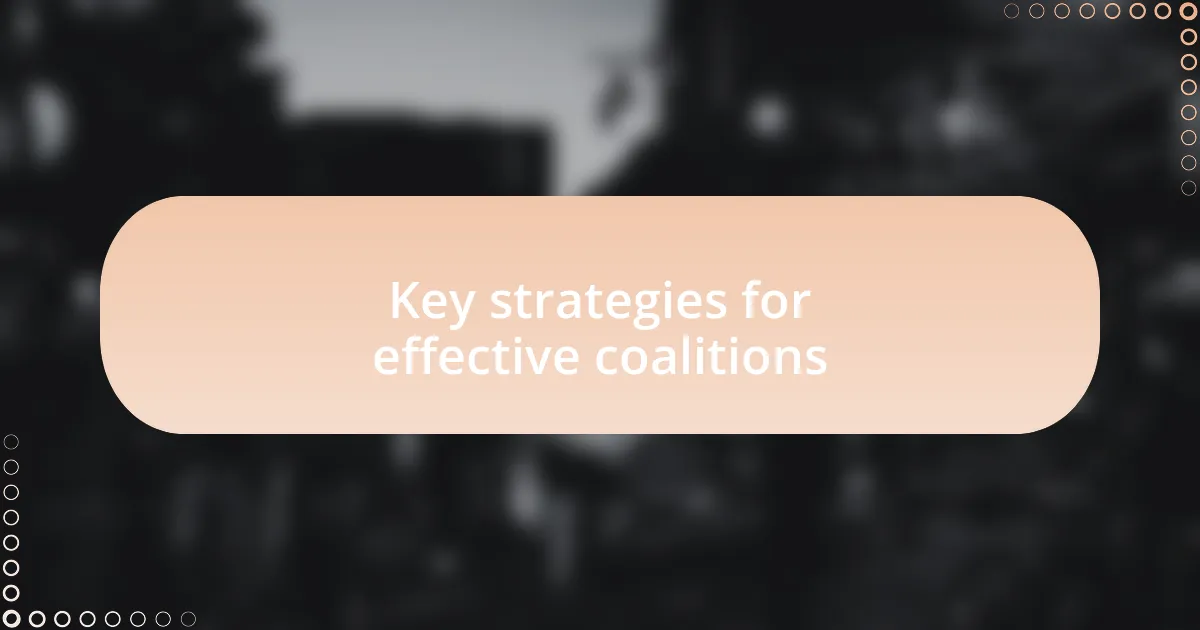Key takeaways:
- Coalition building requires patience, trust, and open dialogue to create a unified front and amplify voices.
- Effective coalitions benefit from clear shared goals, regular communication, and embracing diversity, leading to innovative solutions.
- Building partnerships in activism hinges on mutual respect, shared values, and celebrating collective achievements to foster motivation.
- Overcoming challenges such as communication barriers and differing priorities strengthens coalitions and enhances strategies when approached collaboratively.

Understanding coalition building
Coalition building is like creating a tapestry; each thread represents a different individual or group, each with unique perspectives and goals. I remember a time when I collaborated with local grassroots organizations, each bringing their own flavor to the cause. How could we weave those diverse threads into a single narrative? It took patience and open dialogue, but the result was a unified front that amplified our voices.
When we establish coalitions, we’re not just combining forces; we’re fostering trust. I’ve often found that relationships built on shared values create a stronger foundation than those based merely on aligning interests. Reflecting on my experiences, I recall moments of vulnerability—when we openly discussed our fears and aspirations. How can we expect others to fight alongside us if we don’t first show them our true selves?
Effective coalition building requires constant nurturing. I’ve learned that regular communication is essential in sustaining momentum and addressing conflicts as they arise. Have you ever been part of a group where silence spoke louder than words? I have, and it highlighted the importance of being proactive in discussions to keep everyone engaged and motivated. It’s only by staying connected that we can overcome challenges together.

Importance of coalition in activism
Building coalitions in activism is essential for pooling resources and expertise. I remember when I joined forces with a diverse group that included environmentalists and social justice advocates. It was enlightening to see how our shared mission—peace—allowed us to combine our strengths. This blending of knowledge and skills made our campaign much more effective than if we had stood alone.
Moreover, coalitions amplify voices that would otherwise go unheard. There was a moment during a protest when a young activist, who had previously felt marginalized, stepped up to speak. I watched as her story resonated with many, creating a moment of connection that only a coalition could facilitate. It made me realize how important it is to support each other; through collaboration, we create a platform for all participants to shine.
Ultimately, coalitions foster a sense of belonging that can reinvigorate our passion for activism. I recall feeling overwhelmed during a particularly challenging campaign, but the solidarity of my coalition members reminded me of our collective strength. Isn’t it powerful to see that your struggle is shared? In the heart of activism, that camaraderie is what sustains us through the toughest battles.

Key strategies for effective coalitions
One key strategy for effective coalitions is to establish clear, shared goals among all members. I remember a pivotal meeting where we hashed out our objectives, and it was fascinating to witness how aligning our visions sparked renewed energy and motivation. Have you ever experienced the magic of a well-defined common purpose? It’s remarkable how it can transform a group of individuals into a unified front.
Effective communication is another cornerstone of successful coalitions. In one of our campaigns, we had regular check-ins to ensure everyone felt heard and valued. It was during those discussions that new ideas flourished and conflicts were resolved before they escalated. I often reflect on how essential open dialogue is—without it, dissent can simmer beneath the surface, undermining our unity.
Finally, embrace the diversity of your coalition. I’ve found that welcoming different perspectives can lead to innovative solutions. In one particular project, we had members from various backgrounds, and this blend sparked creativity in ways I hadn’t anticipated. When was the last time you thought about how your coalition could benefit from a wider array of voices? It’s a reminder that strength lies not just in numbers, but in the richness of experience and thought each person brings to the table.

Developing partnerships in activism
Building partnerships in activism is about establishing relationships based on mutual respect and shared values. I recall collaborating with a local environmental group where our respective missions complemented each other beautifully. The feeling of having united goals not only reinforced my commitment but also created a sense of camaraderie that fueled our passion. Have you ever felt that spark when working alongside others who share your dedication?
Trust is a crucial element in building these partnerships. During one campaign, I learned just how vital it is to rely on each other’s strengths. I remember a time when another coalition member took the lead on a logistics challenge that I was struggling with, and it taught me the importance of interdependence. How often do we underestimate the power of leaning on one another in times of need?
Lastly, celebrating collective achievements fosters a sense of belonging and motivation. I once organized a small gathering to recognize our partnership’s milestones, and the gratitude expressed by each member was palpable. Can you recall a moment where acknowledging progress brought your group closer together? That celebration not only motivated us to push forward but also reminded us that every small victory is a step toward our shared mission.

Overcoming challenges in coalition building
Challenges in coalition building are inevitable, yet they can lead to incredible growth and resilience. I once faced a significant hurdle when a key partner disagreed with our strategy during a critical campaign. The tension was palpable, but instead of allowing that disagreement to drive us apart, we scheduled a candid discussion. Have you ever turned a conflict into a dialogue? That experience taught me that navigating these waters can often strengthen our bonds and enhance our strategies.
Communication barriers can also pose significant challenges in a coalition. When collaborating with a diverse group, I realized that cultural differences sometimes led to misunderstandings. In one instance, I initiated regular meetings to ensure everyone felt comfortable sharing their views. This not only smoothed over issues but fostered a culture where all voices mattered. How important do you think it is to create spaces for open dialogue in your own collaborations?
Finally, differing priorities can complicate coalition dynamics. I vividly remember a project where financial resources were stretched thin. Some members wanted to focus on short-term results, while others advocated for long-term change. To address this, we held a brainstorming session to align our goals. This collective effort not only clarified our shared vision but also deepened our commitment to one another. Have you found that aligning priorities is key to maintaining unity?

Lessons learned from my experience
Reflecting on my journey, one major lesson I learned is the importance of patience in coalition building. I recall a time when we pushed for immediate results, but the reality of collective decision-making often requires more time than anticipated. It can be frustrating, but I’ve come to appreciate that great things come when we allow others to process information and contribute at their own pace. Have you ever felt the tension between urgency and the need for consensus?
Trust is another cornerstone of a successful coalition. Early on, I undervalued its significance until I witnessed the fallout from a lack of transparency in our meetings. One particular incident involved a surprise announcement that left some members feeling sidelined. This taught me that sharing information openly and involving everyone in the decision-making process cultivates trust and respect among partners. Do you think fostering transparency might enhance your collaborative efforts?
Finally, I learned that flexibility is vital. During one campaign, we faced unexpected resistance that threatened to derail our progress. I remember feeling the weight of uncertainty pressing down on me. Instead of sticking rigidly to our initial plan, we took a step back to reassess and adapt our approach. This adaptability didn’t just save the campaign; it brought us closer together, revealing the power of unity in the face of adversity. Have you ever had to pivot in a project, and how did it reshape your perspective on teamwork?